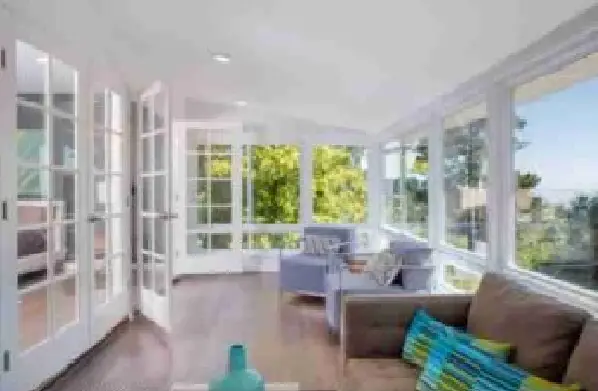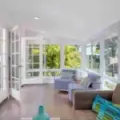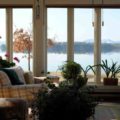Last Updated:May 23, 2025
Heating and Cooling Options for your Sunroom

The sunroom is a great way for homeowners to enjoy the outdoors year-round, but it can be difficult to keep them at the perfect temperature.
There are many different heating and cooling options available that will help homeowners regulate their home’s climate in these spaces. Each of the options will have advantages and disadvantages which should be considered before installing any type of heater or cooler. It’s important to evaluate each on its own merits before making a decision on which one would work best for your home.
Expand home’s current HVAC system
The most professional option is to expand the home’s existing heating and cooling systems. For a sunroom to be counted as part of the home’s total square footage, it will require some form integrated heating and cooling. By connecting the sunroom to the home’s primary HVAC unit, this condition will likely be met by default. The other options on this list will more heavily depend where you live and your local regulations.
Another benefit of extending the vent work from your home to the sunroom addition is that you are using the existing external unit. This is going to limit the cost to the parts and labor for the vent work only.
The final benefit to this is that this option will provide the most budget friendly way of heating and cooling long-term. The home’s large HVAC system will be able to produce the hot or cold air at a fraction of the cost of the other options on the list.
The one caveat is that your current unit needs to be large enough to support the extra area being cooled. We recommend discussing your exact system and sunroom addition plans with a licensed HVAC technician to determine whether or not your existing unit is large enough to handle the increased workload.
Install a Ductless Mini-split Air Conditioning Unit
You can think of this as a small HVAC system that is limited to a small area of the home. Mini-split systems have an outside unit that connects to dedicated vents that are normally only on the exterior walls.
Mini-splits are a cheaper option if your existing HVAC can’t support the extra load. They may be able to be counted as total livable square footage for the home, although this is something that needs to be discussed with a contractor in your area so you know precisely what you need to do.
Also, mini-split systems don’t require opening the walls in the rest of the home to extend the vents. This can mean less work to fix holes in drywall or to paint.
One of the big disadvantages of the mini-split system is that they require an outside unit. I knew someone who installed one of these units to cool their garage, but did so without their HOA approval. This resulted in a HOA violation and some pretty hefty fines. The homeowner was allowed to keep their AC unit, but the whole dispute took months and only resolved after attorneys got involved on both sides.
If you are considering a mini-split system, I strongly suggest ensuring that it’s installation won’t be a violation of any community guidelines.
Portable Air Conditioning Unit
We live in Arizona where the summers can get over 110 degrees. A loss of air conditioning for a few hours can be a very unpleasant experience so several years ago I bought a portable air conditioner. This ensures that even if our main unit goes out, we have the ability to still keep part of our home cool.
Portable air conditioners are all inside the home, and vent the hot air through plastic tube that is vented through a window. The portable AC will have a form that fits in the window with has a hole exactly big enough for the tube from the AC unit. This is gives the hot air somewhere to escape without going back into the room you’re cooling.
Also, the only vent is flush against the window meaning there is nothing protruding, and with window coverings the tubing doesn’t draw a lot of attention to itself.
Portable air conditioners have three main drawbacks. The first is that they are not permanent solutions. If this is your plan for cooling, the room almost certainly won’t be able to be counted as a 4 season sunroom and included in the home’s total square footage.
The second drawback is that the unit is inside. Our unit is about the size of a college mini-fridge, and it has a loud humming noise while running. I can sleep through it, but it bothers my wife enough that she wears ear plugs whenever she’s trying to sleep through it. Additionally, this unit has condensation that drains through a hose in the back. We don’t have a drain close to where we use our portable AC so we have the hose flowing into a bowl that we drain every few hours.
The final drawback is that there will be a limited space that can be cooled with a single unit. Our unit will cool a room of 200 square feet which roughly the size of a master bedroom or a medium sunroom. The cooling is not even as next to the unit is much cooler than on the other side of the room. The portable AC will have a single vent at the top of the unit and all the cold air will flow from that.
We used a ceiling fan and stand fan next to the AC to push the cool air around, and this was acceptable for a temporary solution, but it’s not something I would want to do long-term.
Also, a consideration for the portable AC units is that they are wildly less efficient than either the mini-split or primary AC unit. We calculated that running the portable AC unit to cool just our master bedroom was costing a roughly half the cost our main unit would, but it is cooling a 2500 square foot home instead of a 200 square foot room.
Window Air Conditioning Unit
Window air conditioners are the final cooling option for sunrooms. Window air conditioners can be bought at Home Depot, Lowe’s or Walmart. They are roughly half the price of mini-split systems at each BTU level.
Window units are permanently attached to a window meaning they can’t easily be moved or put up for the winter like the portable AC units discussed in the last section.
Window units do offer more security than portable AC units as they are attached to the window whereas a persistent burglar may be able to use the cracked window used to vent the portable AC as a means into the home.
Window AC units are often more cost efficient cooling options than portable AC units since the majority of the unit is outside allowing all the heat to escape rather than just be vented out through a small tube.
The reason that Window ACs rank so low on our list is because they are simply not allowed in so many areas. They are outside the home so they would require HOA approval, and some areas have simply banned them all together.
Window AC units can also pose a risk to people walking nearby if they become dislodged and fall to the ground. Window AC units were very popular in the 1980s, but their time is now gone. Window units will often have more vents and stronger fans allowing them to cool a wider area of a room compared to portable AC units.
While window AC units don’t require the same type of draining as their interior cousin, you will need to cover them in the winter. Some people choose to completely taken down their window AC in the winter. If it’s an option the homeowner could just close the window if it were left in tact or install an insulated panel if the window was taken out when the AC unit was installed.
Wrapping up
That’s our guide to heating and cooling a sunroom. I hope we’ve answered your questions about the various options and the tradeoffs of each one. Overall, this is going to be an individual decision, and I highly suggest contacting a general contractor or licensed HVAC technician to discuss the options for your sunroom.




